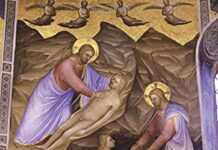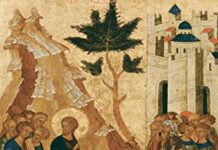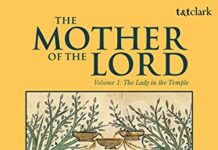
Ebook Info
- Published: 2008
- Number of pages: 212 pages
- Format: PDF
- File Size: 5.51 MB
- Authors: Margaret Barker
Description
In this book, first published in 1991, the prolific and innovative British biblical scholar Margaret Barker sets out to explore the origins and the afterlife of traditions about the Temple in Judaism. Using evidence from the deutero-canonical and pseudepigraphic texts, Qumran and rabbinic material, as well as early Christian texts and liturgies, she advances a host of radical and suggestive theories, including the following: 1. Apocalyptic writing was the temple tradition. 2. Temple buildings were aligned to establish a solar calendar, thus explaining the astronomical texts incorporated in 1 Enoch 3. The temple symbolism of priest and sanctuary antedated the Eden stories of Genesis. 4. The temple buildings depicted heaven and earth separated by a veil of created matter. 5. The throne visions, the basis of the later Merkavah mysticism, originated as high priestly sanctuary experiences, first attested in Isaiah but originating in the royal cult when king figures passed beyond the temple veil from earth into heaven, from immortality to the resurrected state, and then returned.
User’s Reviews
Reviews from Amazon users which were colected at the time this book was published on the website:
⭐Yet again I find myself reading one of Margaret Barker’s works. And, once more, I’ve chosen to explore one of her earlier ones. Gate of Heaven (1991) shares many beats with The Lost Prophet (1988), which focused on the noncanonical Enoch literature, and with The Great Angel (1992), which posits that the ancient cult approached divinity with a two-tiered outlook. In fact, many of her points in this book are identical to those in the other works, albeit she arranges them from a different point of view, here placing the First Temple setting front and center. Likewise, many of the primary documents cited are the same. And yet, even if you’ve read any of her other works, this does not bear the flavor of a retread at all; it remains fresh and engaging, and it flows well.In the first chapter, Barker outlines the history of the Temple(s), along with that of its furnishings and rituals. This chapter lacks Barker’s usual panache and is somewhat dull, in that it is straightforward and workmanlike. On the whole, though, it is a necessary building block to set the stage for the exegesis that follows.The Temple is the scene of both creation and judgment. In its timeless, mythic dimension, it encapsulates the pristine Garden of Eden and, in its tension with the chaos that surrounds it, it also can induce the conflagration of Saint John’s Apocalypse. Hearkening back to Israel’s most primitive mythic vision, the Temple stands at the center of the universe, being God’s first ordered space, a high place raised out above the Deep. At the Temple’s own nexus there exists the Holy of Holies, or the debir, a place of vision and transformation. Within the Temple veil, all time exists simultaneously (111), and entering into it men can perceive heavenly secrets and be glorified. When they emerge again, if they survive, they are angels, messengers bearing revelation (lit. “unveiling”) for the earth. What’s more, divine beings originating within this state can be expelled and fall from grace; the consequence of this for them is mortality. The judgment of such a creature is described in Ezekiel 28, which may present an archetypal pattern for the tradition of the Fall of Adam in Genesis 3 and the fall of the wayward angels in the Book of the Watchers. Barker ties the eternal significance of this mythic event to Irenaeus’s understanding of Christ as a recapitulation of God’s first-formed man in heaven and, consequently, of his role in the renewal of humanity on earth (132).Central to the idea of the intersection that connects heaven and earth is the being who must embark upon the journey between the two. He must necessarily be–at least from the perspective of the earthly side of the veil–a human figure. In earliest times, this figure was likely the Israelite king, whose function was once that of the high priest (75). In keeping with the associated royal framework, there was also at one time a throne within the Holy of Holies, which corresponded to the chariot throne of Yahweh. This is why the throne is so often, in extrabiblical literature, the vehicle of heavenly ascent (98). For some, the anthropomorphic figure on the throne, along with the visions linked to it, presented a danger (135). In particular the Rabbinical Jews, who are heirs to the Deuteronomists and anemic to the concept of an intermediary deity, have historically viewed these First Temple motifs as scandalous and worthy of suppression. Thus they even discouraged the study of the biblical chariot vision of Ezekiel. And yet, at one time, in addition to the king the prophets, priests, and from beyond the veil the Logos were all known to be messengers within this context (159). What I have yet to see Barker offer is an explanation of when, and under what circumstances, the high priestly function of the king might have passed to a specialized high priest. Might the texts provide any indication of what caused the priestly role to be divorced from its original royal connection? Also, might there have been tension between the Temple priesthood and a prophetic figure who experienced visions associated with the Temple but who was not necessarily a priest (such as the First Isaiah)?Barker delves into angelology, especially in the latter half of the book. She compares various descriptions of the cherubim that either surrounded or constituted the throne. She also weighs in on which description may have been primary (or the more historical)–that of the miniaturized cherubim above the desert ark, or else the description of the two or four cherubim that inhabited the Temple? (She is inclined toward the latter.) Barker also gives a plausible explanation for the thinking behind the cherubim throne: Yahweh was sometimes envisioned as riding upon a cherub (142, Ps. 18).Her treatment of angels presents the reader with various ways to conceive of the forms of spirits: as winds, fire, men, and sometimes torches (167). Her quotation of a DSS passage describing them as “woven” and “engraved”–a reference to their depiction on the veil of the Temple–perhaps prefigures her examination of the angelic role in creation vis-à-vis the ancient idea of “hwq” and “surot” in Temple Theology: An Introduction (2004). She also treats angels positionally; the descriptions of named angels located around the chariot throne–either at its right hand or its left–may evince a developing Trinitarian schema. Barker even begins to speak of what the essence of angels may be in their relation to God. They are like “a torch kindled from the fire” (176). They have an independent existence while retaining an inseparable affinity to God. This sounds like pre-Christian Christology!I can offer a few more brief but random points of interest that stuck out to me. Barker identifies Christ’s temptation in the wilderness (Lk. 4) as being grounded in Temple imagery (130). Her point here is that Satan, in showing Christ the kingdoms of the world in a moment of time, demonstrates the panoramic quality of the Temple and the veil. But Barker’s point rings true more broadly: Satan is masquerading as an angel, and the entire scene has parallels to the Daniel’s vision, which is even more undoubtedly a reflection of the Temple. (The linguistic similarities between Luke 4 and Daniel 7:14, and the similarities between the function of Satan and the angel, are cited in George Nickelsburg’s Resurrection, Immortality, and Eternal Life in Intertestamental Judaism and Early Christianity.)Barker analyzes language relating to the Lord’s enthronement as King in Psalms 93-99, and she speculates about this scene’s connection to an Israelite enthronement ceremony, one that was centered on the harvest and which evoked the psalms’ judgment imagery (147). Aside from its punitive dimension, I would have been interested to get her take on the implication of the related features that dominate these same psalms, namely God’s justice and righteousness. Much study has gone into Near Eastern kings “doing” righteousness upon their coronation and ascent to the throne. Announced with the lifting of a torch or the blasting of a horn, their enthronement often accompanied acts of beneficence such as releasing prisoners and forgiving debts. Might not this imply an outpouring from the throne that could be viewed in a positive light?Barker’s works always leave room for further reflection and investigation, and Gate of Heaven is no exception. It reconstructs the worldview of the First Temple and links it to the basic and operative understanding of apostles, rabbis, and fathers who lived and wrote long after the Babylonians put an end to the cult. The poetry of Ephrem the Syrian, which was written in the fourth century and which Barker cites, is but one stunning example of the enduring impact that the imagery of the Temple holds for the life of the Church.
⭐This was my first foray into M. Barker’s prolific writings.IT IS INCREDIBLE: Profound; insightful; inspiring.This book has an academic flair, but is easy to read for most laity. It seems to strike a balance between fluff and academic. In other words, it had plenty of suppport for its claims, but I didn’t get bored in the footnotes It is incredibly insightful about the ancient Temple and its symbolism. These symbols continue today in Judaism, Christianty and Islam. I wrote notes in the pages, underlined and reread. I found myself shaking my head with surprise and insight. I felt my eyes were opened to my own religious practices over and over. I actually said, “WOW!” outloud while reading it and would quote parts to friends I was so fascinated.I found myself very inspired and intrigued by her study of ancient symbols. I continued on to read most of her other books. Most are equally insightful, but this is a shorter, more approachable text for most.If you have a basic understanding of the ancient temple or judeo-christian symbolism, this will be interesting and a must read. If this is your first book on these subjects, you might need to start with more of a survey or lighter introduction.
⭐This was my third book by the author and I’ve enjoyed her writing because she seems sincere in her quest for understanding the history of Palestine and its scripture; she’s not trying to prove a dogma or tradition, but appears to offer her unbiased appraisal of the subject. Her conclusions shake the foundations as the Temple Judaism she uncovers is mystical, visionary, and monolatrist and the Christology angelic as well as Trinitarian. Her encyclopedic knowledge of Jewish and Christian writings of late antiquity often makes her worth reading just for the arcane tidbits she dredges out of that vast store. Her insights into the early Gnostics are fascinating, as she convincingly maps the origins of some of those ideas and their place in the evolution of Christian thought. Her insights and opinions always appear respectful of the material, but her conclusions are unflinching.I find her prose enjoyable and easily accessible; I don’t have to use a dictionary when I read her.I expected this book would feature some illustrations, renderings or artist’s impressions of the First Temple but I was disappointed. We learn a lot about the liturgy and the legacy thereof–loved all that–but ultimately I want to be spoon-fed these ideas if I’m being honest. I’d love to see an epic film or cable series based on her proposal of what transpired in ancient Israel.
⭐as usual, whether you agree or disagree, m barker brings research to the table. a good read.
⭐Definitely give Margaret Barker books a close read, very interesting.
⭐The book was exactly what I was looking for. Very interesting and very sound.
⭐I want all of her books, now.
⭐The product came on time. As any Margaret Barker book, it is excellant and thought provoking. I can heartily recommend it and hope more buy it.
Keywords
Free Download The Gate of Heaven: The History and Symbolism of the Temple in Jerusalem in PDF format
The Gate of Heaven: The History and Symbolism of the Temple in Jerusalem PDF Free Download
Download The Gate of Heaven: The History and Symbolism of the Temple in Jerusalem 2008 PDF Free
The Gate of Heaven: The History and Symbolism of the Temple in Jerusalem 2008 PDF Free Download
Download The Gate of Heaven: The History and Symbolism of the Temple in Jerusalem PDF
Free Download Ebook The Gate of Heaven: The History and Symbolism of the Temple in Jerusalem





